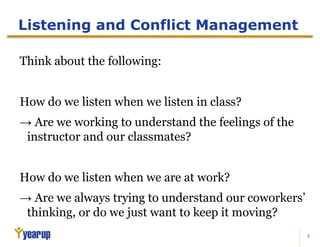Conflict is a normal part of life that arises in relationships due to differing views, values, and goals. It is often caused by miscommunications and misunderstandings between parties. There are several common sources of conflict in the workplace, including goals, personalities, scarce resources, styles, and values. There are five main conflict management styles - accommodating, avoiding, collaborating, competing, and compromising - which can be applied depending on the situation to better manage conflicts through active listening and understanding opposing perspectives.









